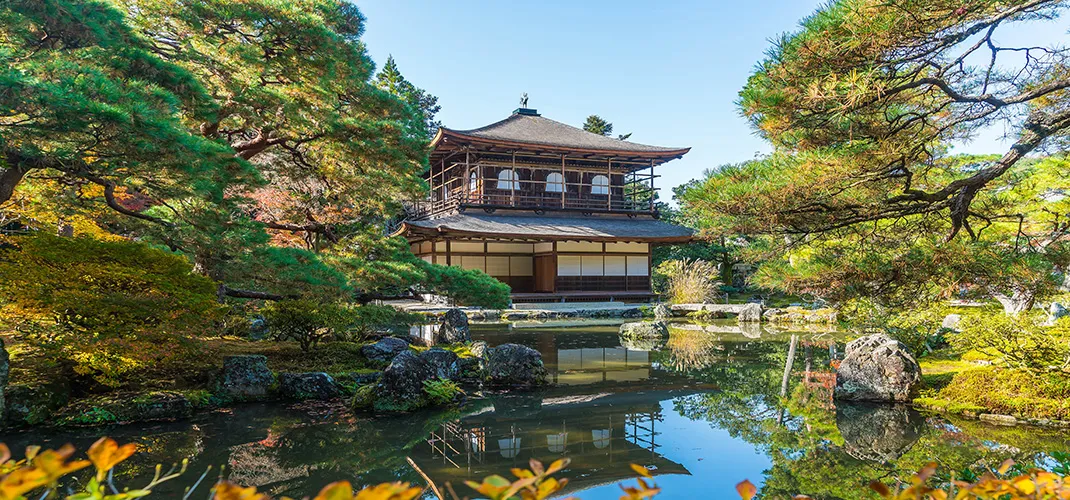Kyoto

Kyoto is a city rich in cultural heritage and natural beauty, offering a multitude of inspiring sights and experiences. Rising 131 metres above central Kyoto, Kyoto Tower offers panoramic views of the city including Kyoto Station, the Imperial Palace and Higashiyama Mountains.
Nijō Castle also a UNESCO World Heritage Site is a historic Castle built by Tokugawa Ieyasu, the founder of the Tokugawa Shogunate. This Castle is celebrated for its elaborate gates and Palace buildings like the Ninomaru Palace, famed for its Nightingale floors that squeak when walked on alerting of intruders.
The UNESCO Worl Heritage Kiyomizu-dera Temple is a Buddhist Temple founded during the Heian period dedicated to the Buddhist deity Kannon of Mercy and Compassion. The Temple's name, Kiyomizu, means ‘Pure Water,’ derived from the Otowa Waterfall within the Temple grounds, known for its sacred waters believed to have wish granting powers.
Discover the stunning Fushimi Inari Taisha, a famous Shinto Shrine renowned for its thousands of vibrant Red Torii Gates that lead up the forested Mount Inari. The Shrine was founded in 711 A.D. and is dedicated to Inari, the Shinto God of Rice, Agriculture and Prosperity. The Fushimi District is recognised for its Sake Breweries, where visitors can experience Sake making through guided tours and tastings.
Walk through Gion, known for its traditional wooden Machiya Town Houses, Teahouses and Geiko culture. The Teahouse’s here offer traditional Matcha Green Tea Ceremonies led by Tea masters. You may even catch glimpses of Geiko and Maiko, an apprentice Geiko.
Explore Arashiyama Bamboo Forest, known for its scenic beauty and historic Temples. Walk through its densely packed Bamboo stalks that soar skyward, creating a natural canopy that feels like entering a different world. Nearby is the Tenryu-ji Temple, a UNESCO Listed Site, is a prominent Zen Buddhist Temple renowned for its expansive Sogenchi Garden including a pond, meticulously arranged rocks and lush vegetation reflecting the changing seasons. Also, the Togetsukyo Bridge or Moon Crossing Bridge is an iconic landmark that spans across the Katsura River and is celebrated for its breathtaking views, especially during the Cherry Blossom season.
Kinkaku-ji, officially named Rokuon-ji, is a Zen Buddhist Temple famous for its Golden Pavilion covered in shimmering Gold Leaf. The Temple grounds are meticulously landscaped and include serene gardens with ponds, islands and walking paths. The Mirror Pond enhances the Golden Pavilion and serves as a scenic backdrop that changes with the seasons.
The Higashiyama District is celebrated for its traditional Japanese architecture, narrow lanes and historical landmarks. Ichinenzaka, Ninenzaka and Sannenzaka are historical streets located in the Higashiyama district that transport visitors to the Edo period. Ichinenzaka and Ninenzaka are renowned for their well-preserved architecture and cobblestone paths where visitors can explore Teahouses, small
Temples and traditional Japanese gardens. From Ninenzaka, Kadai-ji Temple showcases exquisite gardens and historic structures, adding to the area's cultural richness. Adjacent to Ninenzaka is Sannenzaka, which is lined with traditional shops and Teahouses that lead to the Yasaka Shrine, which is one of Kyoto's oldest and revered Shinto Shrines.
The Ginkaku-ji or Silver Pavilion is a Zen Buddhist Temple originally built as a retirement Villa for Shogun Ashikaga Yoshimasa. Modelled after Kinkaku-ji, Golden Pavilion, it was intended to be covered in Silver Leaf, but the Silver was never applied, giving rise to its nickname the Silver Pavilion, Ginkaku.
The UNESCO World Heritage To-ji Temple is known for its historical importance, impressive architecture and cultural heritage. Founded by Emperor Kammu, this is one of Kyoto’s oldest Buddhist Temples featuring notable structures like the Kondo, Golden Hall and the five story Pagoda, which is the tallest wooden Pagoda in Japan.
Ryōan-ji Temple is a Zen Temple founded during the Muromachi period and served as the centre for Zen Buddhism in Kyoto. This Temple is renowned for its dry landscape rock garden consisting of meticulously arranged rocks and white gravel, raked with patterns evoking calmness and simplicity.
The Kyoto Imperial Palace is a significant cultural landmark and was once the residence of the Imperial family until the Capital moved to Tokyo. Surrounded by gardens and walls featuring historic buildings like the Shishinden, which is known for its role in Enthronement Ceremonies.
The Kimono Forest is a captivating artistic installation where traditional Kimono fabrics are displayed in illuminated glass pillars paying homage to Kyoto's textile heritage and cultural beauty. Immerse yourself in Kyoto’s Japanese culture by exploring the historical streets and landmarks with a traditional Kimono rental.
Built to commemorate Kyoto’s millennium as Japan’s Capital, walk through the towering Torii Gate of Heian-jingū Shrine and admire the Shinto and Buddhist architecture. Here, the Jidai Matsuri is held annually to celebrate Kyoto’s heritage with a procession.
Kyoto Station is a major transportation hub in the heart of Kyoto, known for its striking modern architecture and impressive size and serves as a gateway to Kyoto's cultural and historical attractions. The Station is not only a transportation hub but also houses a shopping mall, hotels, various restaurants and even a theatre. The station also features a Skywalk that connects various parts of the Station complex and offers views of Kyoto city and the surrounding mountains.
Other places to include on your visit is the Nishiki Market, known as Kyoto's kitchen, offers a wide range of traditional foods, sweets and local specialties. The Kyoto National Museum is renowned for its collection of traditional Japanese art and artifacts from paintings and sculptures to Archaeological finds. For graphic novel enthusiasts the Kyoto International Manga Museum offers a unique experience dedicated to the history and art of Manga, Japan's popular comic book and graphic novel genre.
Explore the Pontocho district, a labyrinth of narrow alleys lined with traditional Teahouses, restaurants and bars. Here, lantern lit evenings create a magical atmosphere that attracts locals and tourists alike. Kiyamachi Street offers a picturesque riverside setting dotted with charming dining establishments and bars.
Come experience Kyoto’s beauty, cultural and iconic landmarks and maybe even take a Rickshaw ride, guided by knowledgeable locals and pulled by skilled ‘Rikishi’.
